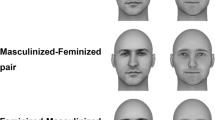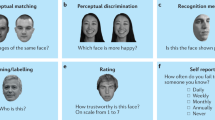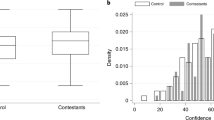Abstract
Impressions of competence from faces predict important real-world outcomes, including electoral success and chief executive officer selection. Presumed competence is associated with social status. Here we show that subtle economic status cues in clothes affect perceived competence from faces. In nine studies, people rated the competence of faces presented in frontal headshots. Faces were shown with different upper-body clothing rated by independent judges as looking ‘richer’ or ‘poorer’, although not notably perceived as such when explicitly described. The same face when seen with ‘richer’ clothes was judged significantly more competent than with ‘poorer’ clothes. The effect persisted even when perceivers were exposed to the stimuli briefly (129 ms), warned that clothing cues are non-informative and instructed to ignore the clothes (in one study, with considerable incentives). These findings demonstrate the uncontrollable effect of economic status cues on person perception. They add yet another hurdle to the challenges faced by low-status individuals.
This is a preview of subscription content, access via your institution
Access options
Access Nature and 54 other Nature Portfolio journals
Get Nature+, our best-value online-access subscription
$29.99 / 30 days
cancel any time
Subscribe to this journal
Receive 12 digital issues and online access to articles
$119.00 per year
only $9.92 per issue
Buy this article
- Purchase on Springer Link
- Instant access to full article PDF
Prices may be subject to local taxes which are calculated during checkout




Similar content being viewed by others
Data availability
All data and stimuli are available on Open Science Framework: https://osf.io/v2j43/.
References
Ballew, C. C. & Todorov, A. T. Predicting political elections from rapid and unreflective face judgments. Proc. Natl Acad. Sci. USA 104, 17948–17953 (2007).
Graham, J. R., Harvey, C. R. & Puri, M. A corporate beauty contest. Manag. Sci. 63, 3044–3056 (2017).
Rule, N. O. & Ambady, N. The face of success: inferences from chief executive officers’ appearance predict company profits. Psychol. Sci. 19, 109–111 (2008).
Stoker, J. I., Garretsen, H. & Spreeuwers, L. J. The facial appearance of CEOs: faces signal selection but not performance. PLoS One 11, e0159950 (2016).
Todorov, A. T., Mandisodza, A. N., Goren, A. & Hall, C. C. Inferences of competence from faces predict election outcomes. Science 308, 1623–1626 (2005).
Bar, M., Neta, M. & Linz, H. Very first impressions. Emotion 6, 269–278 (2006).
Borkenau, P., Brecke, S., Möttig, C. & Paelecke, M. Extraversion is accurately perceived after a 50-ms exposure to a face. J. Res. Personal. 43, 703–706 (2009).
Willis, J. & Todorov, A. T. First impressions: making up your mind after a 100-ms exposure to a face. Psychol. Sci. 17, 592–598 (2006).
Todorov, A. T., Olivola, C. Y., Dotsch, R. & Mende-Siedlecki, P. Social attributions from faces: determinants, consequences, accuracy, and functional significance. Annu. Rev. Psychol. 66, 519–545 (2015).
Aviezer, H. et al. Angry, disgusted, or afraid? Studies on the malleability of emotion perception. Psychol. Sci. 19, 724–732 (2008).
Aviezer, H., Trope, Y. & Todorov, A. T. Body cues, not facial expressions, discriminate between intense positive and negative emotions. Science 338, 1225–1229 (2012).
Freeman, J. B. et al. The neural basis of contextual influences on face categorization. Cereb. Cortex 25, 415–422 (2015).
Freeman, J. B., Penner, A. M., Saperstein, A., Scheutz, M. & Ambady, N. Looking the part: social status cues shape race perception. PLoS One 6, e25107 (2011).
Santamaría-García, H., Burgaleta, M. & Sebastián-Gallés, M. Neuroanatomical markers of social hierarchy recognition in humans: a combined ERP/MRI study. J. Neurosci. 35, 10843–10850 (2015).
Ratcliff, N. J., Hugenberg, K., Shriver, E. R. & Bernstein, M. J. The allure of status: high-status targets are privileged in face processing and memory. Personal. Soc. Psychol. Bull. 37, 1003–1015 (2011).
Fiske, S. T., Cuddy, A. J. C., Glick, P. & Xu, J. A model of (often mixed) stereotype content: competence and warmth respectively follow from perceived status and competition. J. Personal. Soc. Psychol. 82, 878–902 (2002).
Durante, F. et al. Nations’ income inequality predicts ambivalence in stereotype content: how societies mind the gap. Br. J. Soc. Psychol. 52, 726–746 (2013).
Mattan, B. D., Kubota, J. T. & Cloutier, J. How social status shapes person perception and evaluation: a social neuroscience perspective. Perspect. Psychological Sci. 12, 468–507 (2017).
Carroll, J. M. & Russell, J. A. Do facial expressions signal specific emotions? Judging emotion from the face in context. J. Personal. Soc. Psychol. 70, 205–218 (1996).
Fiske, S. T. Envy Up, Scorn Down: How Status Divides Us (Russell Sage Foundation, 2011).
WHO Europe. Poverty, Social Exclusion and Health Systems in the WHO European Region (WHO Regional Office for Europe, 2010).
Mani, A., Mullainathan, S., Shafir, E. & Zhao, J. Poverty impedes cognitive function. Science 341, 976–980 (2013).
Mullainathan, S. & Shafir, E. Scarcity: Why Having Too Little Means So Much (Macmillan, 2013).
Bargh, J. A. in Dual-process Theories in Social Psychology (eds Chaiken, S. & Trope, Y.) 361–382 (Guilford Press, 1999).
Phalet, K. & Poppe, E. Competence and morality dimensions of national and ethnic stereotypes: a study in six Eastern-European countries. Eur. J. Soc. Psychol. 27, 703–723 (1997).
Kraus, M. W., Park, J. W. & Tan, J. J. X. Signs of social class: the experience of economic inequality in everyday life. Psychol. Sci. 12, 422–435 (2017).
Darley, J. M. & Gross, P. H. A hypothesis-confirming bias in labeling effects. J. Personal. Soc. Psychol. 44, 20–33 (1983).
Faul, F., Erdfelder, E., Lang, A.-G. & Buchner, A. G*Power 3: a flexible statistical power analysis program for the social, behavioral, and biomedical sciences. Behav. Res. Methods 39, 175–191 (2007).
Ma, D. S., Correll, J. & Wittenbrink, B. The Chicago face database: a free stimulus set of faces and norming data. Behav. Res. Methods 47, 1122–1135 (2015).
Miller, G. A. WordNet: a lexical database for english. Commun. ACM 38, 39–41 (1995).
Thornton, M. A. affectr: R package for 3-D sentiment analysis. R version 3.0 https://github.com/markallenthornton/affectr(2018).
Bojanowski, P., Grave, E., Joulin, A. & Mikolov, T. Enriching word vectors with subword information. Trans. Assoc. Comp. Ling. 5, 135–146 (2017).
Acknowledgements
We thank B. Labbree, R. Drach, S. Anjur-Dietrich, A. Duker and K. Solomon for help with running the experiments. This work was supported by the National Science Foundation (award no. 1426642) and the Sloan Foundation (grant no. 2014-6-16). The funders had no role in study design, data collection and analysis, decision to publish or preparation of the manuscript.
Author information
Authors and Affiliations
Contributions
E.S. and A.T. devised the study concept. All authors designed the experiments and wrote the manuscript. D.O. collected and analysed data.
Corresponding author
Ethics declarations
Competing interests
Authors declare no competing interests.
Additional information
Peer review information Primary handling editor: Aisha Bradshaw
Publisher’s note Springer Nature remains neutral with regard to jurisdictional claims in published maps and institutional affiliations.
Supplementary information
Supplementary Information
Supplementary Results, Figs. 1–8, Supplementary Tables 1–3 and Supplementary References.
Rights and permissions
About this article
Cite this article
Oh, D., Shafir, E. & Todorov, A. Economic status cues from clothes affect perceived competence from faces. Nat Hum Behav 4, 287–293 (2020). https://doi.org/10.1038/s41562-019-0782-4
Received:
Accepted:
Published:
Issue Date:
DOI: https://doi.org/10.1038/s41562-019-0782-4
This article is cited by
-
Status cues and moral judgment: Formal attire induces moral favoritism but not for hypocrites
Current Psychology (2024)
-
Perceptions of Ethicality: The Role of Attire Style, Attire Appropriateness, and Context
Journal of Business Ethics (2024)
-
Red background color biases gender categorization of human faces
Scientific Reports (2023)
-
Effects of masculinity vs. femininity on competence judgement of politician faces and election outcome prediction
Scientific Reports (2023)
-
Distrust as a form of inequality
Scientific Reports (2023)



